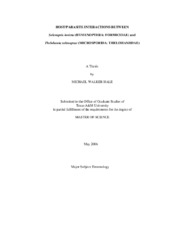| dc.description.abstract | Thelohania solenopsae Knell, Allen and Hazard is a microsporidian pathogen that infects the red imported fire ant Solenopsis invicta Buren. This five part study examined the effects that T. solenopsae has on constructs of colony fitness in field mounds and adoption rates, how T. solenopsae spores are affected by different stable temperatures. This study also examined the effects on T. solenopsae spores due to centrifugation out of the host cell, pH of the solution the spores are kept, and food classes that could be ingested by S. invicta. For the first study, a total of 29 colonies were collected, 16 infected, and 13 uninfected. The study concluded significantly lower brood production in uninfected field colonies when compared to infected field colonies. Additionally, the total number of queens per colony is significantly greater in T. solenopsae infected mounds with 35.4±31.9 queens for infected mounds and 15.5±11.2 queens for uninfected mounds, demonstrating a possible host response to parasite infection. In the study examining stable temperature effects on T. solenopsae spore growth and spore type, a stable temperature of 31°C induced greater production of binucleate free spores in worker S. invicta. There was an overall decrease of T. solenopsae octospores at 16°C, 26°C and 31°C. The studies concerning extraction of T. solenopsae spores, and inclusion in food infusions demonstrated viable spore recovery after centrifugation, verified by using Calcofluor M2R and Sytox Green dual staining. This study demonstrated significant decreases in spore viability over a 10 week period. The study concerning pH demonstrated significant effects of differing pH parameters with the best viable spore recovery at pH 4 and no spore recovery at pH 1 and pH 2. The least viable spore recovery occurred at pH 6 and pH 12 after 24 hours of emersion verified by using Calcofluor M2R and Sytox Green dual staining. | en |


